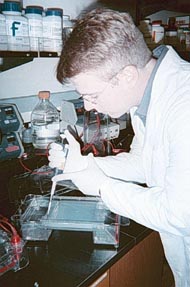 Identification of E. coli
Identification of E. coli
|
 Loading gels for DNA analysis |
Problem
The
Commonwealth of Virginia is required to develop Total Maximum Daily Loads (TMDLs)
for stream segments that violate water quality standards for fecal
coliform bacteria. One of the
major difficulties in establishing these TMDLs is the uncertainty inherent
in identifying specific sources of fecal coliform bacteria in the streams.
Source tracking of fecal coliform
bacteria will provide more accurate
waste-load allocations and will enhance the development and defensibility of
TMDLs.
Objective
The
objectives of this study are: (1) to test and determine the effectiveness of
bacteria source tracking in identifying the sources of fecal contamination in
three stream segments covering a range of agricultural and urban sources; (2) to
evaluate and demonstrate the utility of source tracking to enhance model
waste-load allocations, calibration, and verification.
Relevance and Benefits
In
terms of projects of statewide importance, this project will demonstrate
an innovative approach and provide needed TMDL development support. The project will benefit the Commonwealth by introducing a
demonstrated state-of-the-art bacteria source-tracking technique to Virginia.
The project will also educate the public and state and federal policy
makers on the range of fecal coliform bacteria contaminant sources in urban,
agricultural, and mixed land-use watersheds that are on the Commonwealth's TMDL
priority list. Most importantly,
this study will demonstrate the ability to improve watershed-modeling
techniques, which will be widely applied over the next decade in the development
of TMDLs for hundreds of stream segments in Virginia and other mid-Atlantic area
states. The significance of the
proposed project is that it has the potential to provide improved bacterial
source information in place of the "best guesses" that are currently
being used for waste-load allocations, and thereby can strengthen the modeling
results and the defensibility of the TMDLs.
Approach
Ribotyping,
an analysis of the genetic material that codes for ribosomal RNA production of E. coli
(originating in the digestive tract of warm-blooded animals), will be used to determine the dominant sources of fecal coliform in the
impaired stream segments. Samples
will be collected over a range of hydrologic conditions from both the
contaminated surface waters and all potential significant sources of fecal
contamination. The gene for ribosomal RNA
production of
E. coli isolates in the three surface water segments will be compared with
isolates of defined sources within each watershed to determine major
contributors to the fecal contamination. The
source-tracking distribution determined in each segment will be used to modify
and strengthen the waste-load allocations in the TMDL watershed model.
